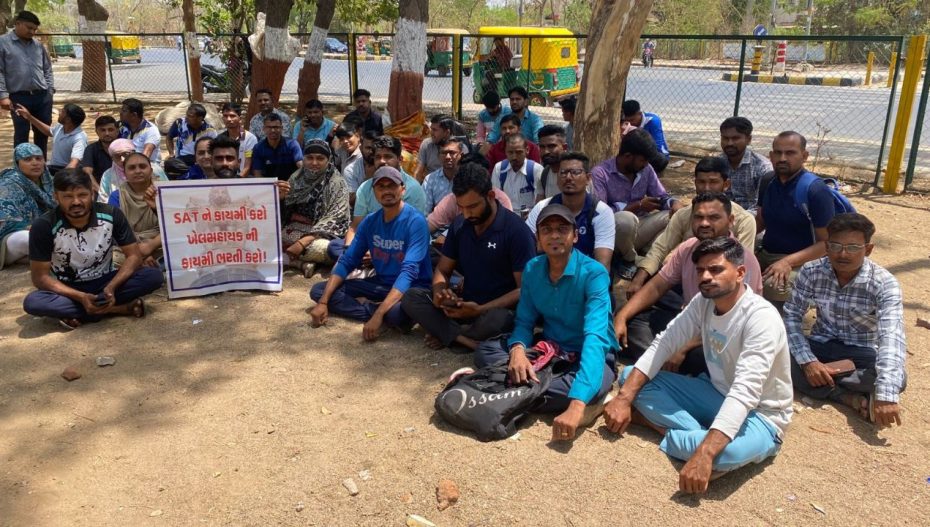Despite having a crucial role in students’ physical and mental well-being, being a sports teacher often feels like a thankless job. While math, literature, and social studies teachers are celebrated for academic success, sports educators remain underappreciated. Their contribution to discipline, teamwork, and resilience is rarely acknowledged in formal education narratives. Limited pay, lack of job security, and exclusion from decision-making further reflect this disparity.
As Gujarat enters the second year of appointing contractual sports teachers under the Khel Sahayak scheme, discontent among sports teachers continues to grow. During the state’s budget session, a week-long protest took place in Gandhinagar. According to a report, the situation escalated last month, when several demonstrators were detained while attempting to march to the Legislative Assembly.
This year, the state government has once again raised the upper age limit for applicants in this field—now set at 40 years, up from the 38-year cap introduced during the first phase of the scheme. Initially, the age limit was fixed at 35 when the scheme was launched in July 2023.
For the 2024–25 academic year, the Gujarat government has appointed 1,527 khel sahayaks. Despite this, many appointees and protestors argue that the scheme neither secures the rights of teachers nor adequately serves students. A core concern remains the absence of any regular recruitment of sports teachers over the past 15 years. Additional issues raised include delays in salary payments, lack of transparency around contract renewals, and the urgent demand for regularisation of appointments.
The protests have garnered support from political groups. Both the Congress and the Rashtriya Swayamsevak Sangh’s sports wing, Krida Bharati, have backed the movement, calling for the regular appointment of sports teachers. These organisations argue that the state’s failure to fill such posts undermines its ambition to host the 2036 Olympics and contradicts its emphasis on promoting sports.
Education Minister Kuber Dindor confirmed that the renewal of the current batch of khel sahayaks was still under consideration. He mentioned that besides increasing the age limit, the government was reviewing policies around leaves and contract renewals. There is also a possibility of creating additional posts following the age revision.
Under the scheme outlined in notifications issued on July 7 and July 10, 2023, for primary and secondary schools respectively, one khel sahayak is to be appointed in schools with more than 300 students. Selection is based on a merit-cum-preference system, using scores from the Sports Aptitude Test (SAT) conducted by the State Examination Board (SEB).
As per official figures, the state education department has identified 4,545 vacancies in primary schools and around 70 in secondary schools. However, Samagra Shiksha, an integrated school education scheme in India, encompassing all levels from pre-school to Class XII, has released only a provisional merit list of 1,588 candidates for primary school roles, despite over 1,700 individuals qualifying via the SAT.
The khel sahayaks receive a monthly salary of Rs 21,000 on an 11-month contract. The continuation of service is subject to a review by the School Management Committee (SMC), which includes a Cluster Resource Centre Coordinator (CRC). This scheme will be active until the completion of the Mission School of Excellence, ending in 2027–28, after which the government will conduct a review to determine whether the scheme should be extended.
Krida Bharati recently submitted a memorandum to all district collectors in Gujarat, criticising the absence of recruitment for primary, secondary, and higher secondary sports teachers over the past 15 years. They urged the state government to begin regular recruitment immediately.
A delegation led by Krida Bharati Western Region Coordinator Rameshbhai Prajapati also visited the Ahmedabad district collector last week to push the demand further.
Admitting that the last regular appointment of sports teachers occurred in 2010, Minister Dindor explained that the Right to Education Act permits only partial appointments. He noted that the SAT was conducted after a 15-year gap, and emphasised that converting khel sahayak roles to permanent ones—like Vidhya Sahayaks—would require a policy change. He added that doing so might trigger similar demands from music and arts teachers. He further clarified that the government resolution (GR) explicitly stated that khel sahayaks are not entitled to paid vacation leave.
The Gujarat Youth Congress, in a separate representation to Governor Acharya Devvrat and Chief Minister Bhupendra Patel, highlighted the lack of regular recruitment since 2010 in schools and no recruitment of Physical Training Instructors (PTIs) in colleges since 2012.
Youth Congress spokesperson Subhan Saiyed to a media house that even grant-in-aid colleges had not hired any sports teachers since 2012, and no PTI appointments had been made in government colleges after 2015. He noted that there was no clarity on the validity of SAT results, unlike TAT-1 and TAT-2 exams conducted in 2018–19, which had a five-year validity.
Saiyed added that many candidates who had cleared the SAT were now nearing or exceeding the age limit, and if the government had no plans to recruit them, it should consider shutting down the institutions that train sports teachers and charge high fees. He also demanded that the complaints filed against protesting teachers be withdrawn.
Also Read: Kathak’s soulful innovator Kumudini Lakhia passes away https://www.vibesofindia.com/kathaks-soulful-innovator-kumudini-lakhia-passes-away/












